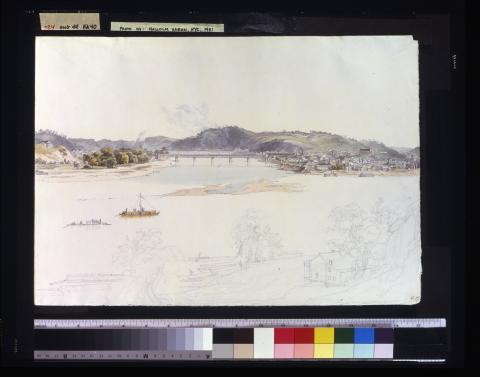September 18, 1832
18 September: A large number of passengers had arrived, and the crowding inside the coach was great, for we had eleven passengers, including two women and four children, whose screaming in the very oppressive heat was unbearable.[Page 1:97] Since I had much baggage, I had to pay a dollar more: for 51 or 52 miles and two persons, seven dollars, or seventeen and one-half florins. The region from Reading onward has variety. Fields of corn are often very extensive; there are also fields of clover, in which cattle graze. Everywhere the region is divided by means of zigzag fences, and this does not contribute to its  beauty. Woods occur frequently. Large, beautiful farmsteads with large barns, big orchards, often with clover in them, and [livestock] resting in the shade. The trees are heavy with apples. These thrive, but not the plums. Peaches do well. In Reading I saw whole wagons full of them, with people crowding around while children were stealing some of them. The floors of the woodlands are all clear and have no underwood.
beauty. Woods occur frequently. Large, beautiful farmsteads with large barns, big orchards, often with clover in them, and [livestock] resting in the shade. The trees are heavy with apples. These thrive, but not the plums. Peaches do well. In Reading I saw whole wagons full of them, with people crowding around while children were stealing some of them. The floors of the woodlands are all clear and have no underwood.
We passed Cacoosing Creek and reached the village of Womelsdorf, where we ate lunch. It is 14 miles to here from Reading. Then we passed Tulpehocken Creek and the Swatara River, that empties into the Susquehanna. Also the Union Canal several times; [the canal] runs from Baltimore to Pittsburgh and is finished except for a short stretch. It is said already to [have] cost eighteen million dollars but will later be of great value for the commodities. We pass through the towns Stouchsburg and Myerstown on the way to Lebanon, a market town in Lebanon County near which there is a settlement of Moravians. We cross the Swatara River, which empties into the Susquehanna. The region around Lebanon is pleasantly varied and hilly. It has much forest land, with wooded mountains in the distance. When evening came, I joined the driver on the coach box, where a passenger was already sitting. The evening was gloriously warm. The lanterns on the stage were lighted. Cicadas and crickets were chirping loudly; they cannot be compared with those in Brazil, where there is a veritable shrieking during the evening in the forests. Several hours later we saw a large number of lights shining ahead of us in a shallow hollow. This was Harrisburg, our destination.
Harrisburg is a small city of 5,000 inhabitants, with broad streets that cross at right angles. It is located right between the Susquehanna and the Union Canal. The houses are very diverse, some attractive and made of brick, others low and made of wood. Wooden houses, however, are continually being torn down and replaced by new, nicer ones made of brick. There is very great building activity. At the inn where we stayed, there is a large square, where the market building is located, as in most Pennsylvania cities. This square was just being covered with crushed limestone, and it will be very attractive. For the most part, trees have been planted in rows along the houses. The statehouse, with two adjacent buildings, is located on a slight incline near the city by the canal, and everything all around it is neatly trimmed and enclosed. The building itself is sightly, with a row of columns and a dome on top supported by columns. From this dome one has a beautiful view. A second interesting point in this city is along the river. The Susquehanna is very wide, 603 of my paces on the bridge. It has an island right near the city so that a very long, enormous covered bridge with two tunnels—one for those coming, the other for those leaving—has been constructed over each one of its branches. The first bridge is 630 of my paces, the second one also more than 600 paces in length, and in the former there are 23 windows. Furthermore, it has 2 end pillars and 5 freestanding ones made of masonry stone faced with red, squared sandstone. Farther down the river, at Columbia, there is a bridge that is one and a quarter miles and 4 rods long and has 52 pillars.
From the bridge at Harrisburg, the view upriver is especially beautiful. Green, wooded islands adorn the surface of the river, which is broad but shallow and, especially now during the dry season, would not permit navigation. It costs three cents to cross the bridge. Harrisburg (a borough) is the capital of Pennsylvania and the residence of the governor, at the present time Wolf, a man who will probably be reelected because he is popular. It is estimated that there are 500 blacks, i.e., colored persons, in this city.[Page 1:98]There are Germans everywhere, including a skilled German physician. Because of our indisposition, I turned to an English doctor, since I did not know about the other one, and we spent three days here quite indisposed and fatigued.



